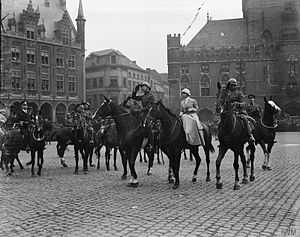Battle of Courtrai (1918)
| Battle of Courtai, 1918 | |||||||
|---|---|---|---|---|---|---|---|
| Part of the Western Front of World War I | |||||||
 King Albert I of the Belgians with his wife, Queen Elisabeth enter Bruges alongside Admiral Roger Keyes and the 1st Earl of Athlone 25 October 1918 | |||||||
| |||||||
| Belligerents | |||||||
|
| |||||||
| Commanders and leaders | |||||||
|
|
| ||||||
| Casualties and losses | |||||||
| Not available |
Not available 12,000 soldiers captured 550 artillery pieces captured. | ||||||
The Battle of Courtrai (also known as the Second Battle of Belgium (French: 2ème Bataille de Belgique) and the Battle of Roulers (French: Bataille de Roulers)) was one of a series of offensives in northern France and southern Belgium that took place in late September and October 1918.
Background
The Groupe d'Armées des Flandres (GAF) comprising twelve Belgian divisions, ten divisions of the British Second Army) and six divisions of the French Sixth Army, under the command of King Albert I of Belgium, with the French General Jean Degoutte as Chief of Staff, defeated the German 4th Army in the Fifth Battle of Ypres ((28 September – 2 October).[1] The breaking of the Hindenburg Line further south, led the Allies to follow a strategy of pursuing the Germans for as long as possible, before movement was stopped by the winter rains. Mud and a collapse of the supply-system, had stopped the advance in early October but by the middle of the month, the GAF was ready to resume the offensive.[2][3]
Battle
The offensive began at 5:35 a.m. on 14 October, with an attack by the GAF from the Lys river at Comines northwards to Dixmude. The British creeping barrage advanced at a rate of 100 yards (91 m) per minute, much faster and much further than the practice in 1917, in expectation that there would be little resistance from German infantry.[4] By the evening the British forces had reached high ground which dominated Werviq, Menin and Wevelghem in the south; further north the British captured Moorslede and closed up to Gulleghem and Steenbeek. Belgian troops on the left reached Iseghem, French troops surrounded Roulers and more Belgian troops captured Cortemarck.[5]
Roulers fell the next day and by 16 October, the British held the north bank of the Lys up to Harelbeke and had crossed the river at several points.[6] By 17 October, Thourout, Ostend, Lille and Douai had been recaptured; Bruges and Zeebrugge fell by 19 October and the Dutch border was reached the following day.[7] The crossing of the Lys and the capture of Courtrai by the British Second Army on 19 October, led to a German retreat on the front of the Fifth Army further south, which encircled Lille on 18 October.[8] Next day the British were in Roubaix and Tourcoing and by the evening of 22 October, the British had reached the Scheldt from Valenciennes to Avelghem.[9]
Aftermath

By the time the Armistice had been signed, the front was an average of 45 miles (72 km) east of the old front line and ran from Terneuzen to Ghent, along the River Scheldt to Ath and from there to Saint-Ghislain, where it joined with the BEF positions on the Somme.[10]
See also
- Battle of Courtrai (disambiguation), for other battles with this name
Footnotes
- ↑ Edmonds & Maxwell-Hyslop 1947, pp. 1–2.
- ↑ Sheffield 2011, p. 318.
- ↑ Edmonds & Maxwell-Hyslop 1947, pp. 269–271.
- ↑ Harris & Barr 1998, p. 242.
- ↑ Boraston 1919, p. 290.
- ↑ Edmonds & Maxwell-Hyslop 1947, pp. 271–276.
- ↑ Edmonds & Maxwell-Hyslop 1947, pp. 276–294.
- ↑ Sheffield 2011, p. 329.
- ↑ Boraston 1919, p. 291.
- ↑ Edmonds & Maxwell-Hyslop 1947, pp. 426–453, 546–551.
References
- Boraston, J. H. (1919). Sir Douglas Haig's Despatches (1920 ed.). London: Dent. OCLC 633614212.
- Edmonds, J. E.; Maxwell-Hyslop, R. (1947). Military Operations France and Belgium 1918: 26th September – 11th November The Advance to Victory. History of the Great War Based on Official Documents by Direction of the Historical Section of the Committee of Imperial Defence V (IWM & Battery Press 1993 ed.). London: HMSO. ISBN 0-89839-192-X.
- Harris, J. P.; Barr, N. (1998). Amiens to the Armistice: The BEF in the Hundred Day's Campaign, 8 August – 11 November 1918. London: Brassey's. ISBN 1-85753-149-3.
- Sheffield, G. (2011). The Chief: Douglas Haig and the British Army. London: Aurum Press. ISBN 978-1-84513-691-8.
External links
- The Hundred Days, 18 July-11 November 1918
- Situation au Debut D'Octobre 1918 (in French)
- CWGC Map, Victory offensive 1918
| ||||||||||||||||||||||||||||||||||||||||||||||||||||||||||||||||||||||||||||||||||||||||||||||||||||||||||||||